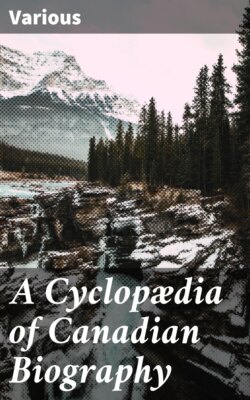Читать книгу A Cyclopædia of Canadian Biography - Various - Страница 72
На сайте Литреса книга снята с продажи.
Macfarlane, Thomas
ОглавлениеTable of Contents
Macfarlane, Thomas, Chief Analyst, Inland Revenue Department, Ottawa, Ontario, was born on the 5th March, 1834, at Pollokshaws, parish of Eastwood, county of Renfrew, Scotland. His father, Thomas Macfarlane, was a native of Pollokshaws, and his mother, Catherine, was born in the adjoining parish of Mearns. Mr. Macfarlane, jr., was educated in Pollokshaws, at the Andersonian University, Glasgow, and at the Royal Mining School of Freiberg, in Saxony. In the latter school he studied chemistry, metallurgy, mineralogy, and geology. After leaving Freiberg in 1857, he travelled through the Erzgebirge and Bohemia, and then went to Norway, as director of the Modum smelting works and Cobalt mines. During his stay in Norway he visited most of the southern part of that country, including Ringerike, Nummedal, Thelemarken and Saetersdal. In 1860 he emigrated to Canada, and took charge of the Acton, and afterwards of the Albert mine in the Eastern Townships, province of Quebec. In 1865-6 Mr. Macfarlane became field-geologist under the late Sir William Logan, and helped that illustrious gentleman on the geological survey of Canada. In the volume of geological reports published in 1866, Mr. Macfarlane supplies reports on Hastings county and the Lake Superior district. In 1868 he explored the Montreal Mining Company’s locations on Lake Superior, and was the discoverer of the celebrated Silver Islet mine. In 1871 he paid a visit to the mining districts of Colorado, Utah, and Nevada; and in 1873 he revisited England, and then travelled through Germany and Norway. On his return to Canada, in 1876, he visited Nova Scotia and Cape Breton; also Ecuador and Peru, and published a description of the latter journey under the title of “To the Andes.” In 1879 he spent six months smelting in Leadville, Colorado. In 1881, visited mining districts on the Lower Colorado and in Southern Utah, travelling from Fort Yuma to Salt Lake City. In 1884 he revisited England and Germany; and here we say, Mr. Macfarlane speaks the German, French and Danish languages fluently. In 1886 he was appointed by the Dominion government chief analyst for Canada, and is now settled down at Ottawa. In 1882 he was appointed a member of the Royal Society, Canada, and elected president of the Chemical section in 1886. In 1885 he became a member of the Imperial Federation League, and in February, 1886, and January, 1887, contributed articles to its “Journal.” Mr. Macfarlane has devoted nearly all his life to science, and as a chemist, metallurgist, miner, and explorer, he stands very high. His scientific papers are numerous, and by referring to the pages of The Canadian Naturalist, will be found there on: “Primitive Formation in Norway,” “Acton Copper Mine,” “Eruptive Rocks,” “Copper Extraction,” “Production of Soda and Chlorine,” “Copper-beds of Portage, Lake Michigan,” “Geological Formations of Lake Superior,” “Silver Ore of Wood’s Location,” “Origin of Crystalline Rocks,” “Canadian Geology.” In the pages of “Transactions of the Institute of Mining Engineers,” papers on “Slag Densities,” “Classification of Original Rocks,” “Silver Islet.” And some others in the “Proceedings of the Royal Society of Canada.” Mr. Macfarlane was reared a Presbyterian in the U. P. Church of Scotland, and while a young man adopted materialistic views, but has since abandoned them, and is now a member of the Anglican church. He married in September, 1858, Margaret Skelly, niece of Dr. John Litster, Pollokshaws, Scotland, and they have nine children, all living.
